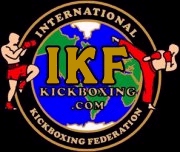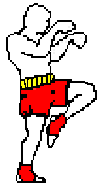IKF
JUNIOR
MUAY
THAI RULES

HOME - NEWS - EVENTS - RANKINGS - SANCTIONING INFO - JOINING - RULES & REGULATIONS - MERCHANDISE - ISCF
Junior
MUAY THAI Rules (JMTR)
- JMTR STRIKES & TECHNIQUES
- NO ELBOWS are Allowed In IKF Junior MUAY THAI Bouts.
- Fighters may strike with Punches, Kicks and Knees;
- KICKS (shin or foot) & KNEES are allowed to BOTH legs (not the knees) of each fighter.
- KICKS may strike body and head as well.
- KNEES are NOT ALLOWED TO STRIKE ABOVE The SHOULDERS, Only below the Shoulder Line.
- Clinching is allowed as long as 1 fighter is ACTIVE WITHIN the clinch.
- MUAY THAI Throws are LEGAL in IKF Junior MUAY THAI. NOT HIP THROWS.
- Fighters are allowed to catch their opponents leg and take 1 step forward. After 1 step, the fighter holding the leg must STRIKE before taking a second step or more.
- Sweeps (With instep of foot) are not allowed but a fighter may "KICK" his/her opponents supporting leg with the top of their foot or shin, NOT the instep as in a karate style sweep.
- No strikes are allowed to the groin or joints of the leg.
- In TRUE MuayThai as with these rules, FLASH KNOCKDOWNS where the knocked down fighter rises up immediately after being knocked down are NOT COUNTED AS A KNOCKDOWN OR STANDING 8 COUNT.
- Direct (Side Kick Style) kicks to the front of a fighters legs Are NOT ALLOWED.
- Kicks (shin or foot) may strike the inside and outside of each
fighters legs.
- JMTR DRESS CODE
- Shorts are mandatory under
IKF MUAY THAI RULES.
This will curtail the crowd from yelling at a fighter to "Stop Kicking To The Legs" which is often heard at ringside if the fighter is wearing Long Pants. - MUAY THAI SHORTS ONLY! Not board shorts, mma shorts, wrestling
shorts, etc. etc.
- Shorts are mandatory under
IKF MUAY THAI RULES.
- JMTR SAFETY EQUIPMENT
- ALL EQUIPMENT Used by EVERY FIGHTER on EVERY IKF must be approved by the IKF.
- Foot Pads (Like in the old PKA Full Contact Karate Days) are NOT ALLOWED
- Headgear Is Mandatory.
- Shin Pads Are Mandatory.
- Groin Cup is Mandatory.
- Mouthpiece is Mandatory.
- Handwraps are Mandatory.
- Fight Gloves (That will be supplied by all
IKF Event Promoters) are
Mandatory. 8 & 10 Ounce Gloves. See
Weight Classes For
Glove Sizes. (10 & 12 ounce size used in Amateur Tournament Competition)
- JMTR BOUT TIMES
- Ages 8 to 15: 1:30 Minute Rounds - 1 Minute Rests.
- Ages 16 & 17: 2:00 Minute Rounds - 1 Minute Rests.
- JMTR TITLE BOUT LENGTHS
- World, Intercontinental, Continental & National Title bouts on a
Regular Event is 5 Rounds.
- Any TOURNAMENT Bout is 3 rounds.
- State and Regional Title bouts on a Regular Event is 4 Rounds.
- Any TOURNAMENT Bout is 3 rounds.
- Non Title bouts on a Regular Event: 3 Rounds.
- World, Intercontinental, Continental & National Title bouts on a
Regular Event is 5 Rounds.
A Brief Lesson In
Muay Thai 101
 As we here at the IKF have always done for our fans of these pages, we
always try to educate "EVERYONE" on aspects of our sport and maybe a
short class here in Muay Thai 101 will help to form where this article is going.
Some of you may know most if not all we will teach in this class while others
will answer honestly, "Oh, I didn't know that." So let the class begin…
As we here at the IKF have always done for our fans of these pages, we
always try to educate "EVERYONE" on aspects of our sport and maybe a
short class here in Muay Thai 101 will help to form where this article is going.
Some of you may know most if not all we will teach in this class while others
will answer honestly, "Oh, I didn't know that." So let the class begin…
Nearly every weekend around the world there's a kickboxing
event that advertises they will feature the long honored fighting art of
Thailand known as MuayThai. If these fighters are both following true Muay Thai
tradition, they will both  enter the ring over
the top rope. Why? In Muay Thai tradition, the Mongkon (headpiece wore
around the top of each fighters head prior to their bout) is blessed for
good luck by each fighters respected religion. Going over the top rope is
symbolic that God is Above All Things such as the ring ropes. The spectators and
their peers see 2 fighters dressed in the traditional Muay Thai shorts with
their Mongkon wore proudly on their head. Once in the ring the traditional
MuayThai music begins and a fighter has their first options of the bout.
enter the ring over
the top rope. Why? In Muay Thai tradition, the Mongkon (headpiece wore
around the top of each fighters head prior to their bout) is blessed for
good luck by each fighters respected religion. Going over the top rope is
symbolic that God is Above All Things such as the ring ropes. The spectators and
their peers see 2 fighters dressed in the traditional Muay Thai shorts with
their Mongkon wore proudly on their head. Once in the ring the traditional
MuayThai music begins and a fighter has their first options of the bout.
However in Thailand, this is NOT an option and SHOULD NOT be an option even in other parts of the world. These options are not fighting options such as "Should I throw a Jab or a knee etc." these options are the ones of long and honored traditions of Muay Thai. To seal the ring (The walk around the ring which symbolizes the sealing of evil spirits from the ring), begin their Wai Kru (Wai means Bow and Kru means Teacher. When the fighter bows down paying homage to their teacher, club and family) and or a Ram Muay. (Which translates into boxer dance) or to simply stand and await for their opponent to be ready and the referee to begin the bout. Keep in mind that not all Muay Thai fighters perform these things. Even in Thailand, they are a fighters choice.
If a fighter decides to seal the ring we'll see them stopping to pray in each corner. In Thailand, the Wai Khre is paying homage to their Buddha. This pray continues at each corner during their walk to all four corners. Once again, a fighter may now choose to perform a Wai Khre followed by their own version of their Ram Muay. Often during a fighters Ram Muay, many true fans of Muay Thai fighting may not know what the dance is for. To answer this question, the dance expresses a fighters balance and agility. Sometimes at it's end, it may be followed by a show of confidence or challenge towards their opponents corner such as a stomping of their feet or an imitation of shooting an arrow at their opponent. To true fans of the sport, this is all part of the bout as well. As each fighters rituals ends, the trainer removes their Mongkon and turns to face their opponent.
Back To IKF
JUNIOR AMATEURS FRONT PAGE, Click HERE
To
IKF FRONT PAGE, Click HERE
HOME - NEWS - EVENTS - RANKINGS - SANCTIONING INFO - JOINING - RULES & REGULATIONS - MERCHANDISE - ISCF